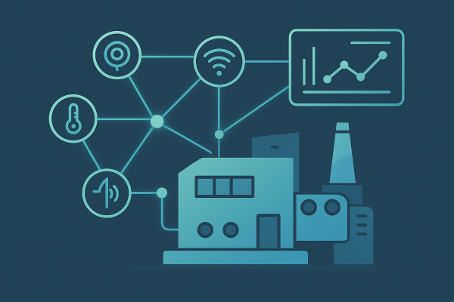In this article, we explain how condition monitoring works, what its advantages are, how it is used in practice, and how you can set up your own system. We place particular emphasis on the ADTANCE PVM solution, which offers scalable and secure condition monitoring for machines.

What is condition monitoring?
Condition monitoring describes the continuous recording of machine status using sensors and software. The condition of a machine is monitored in real time by measuring parameters such as temperature, vibration, pressure, or power consumption using sensors; this allows wear and tear or potential failures to be detected in good time. The aim is to avoid unplanned downtime and increase the service life of the equipment.
Why is machine monitoring important?
Condition monitoring is the basis for predictive maintenance. A well-implemented system offers a wide range of advantages:
- Reduced downtime: Early warnings enable maintenance measures to be planned before unplanned downtime occurs.
- Longer machine service life: If signs of wear are detected in good time, components can be replaced or repaired in a targeted manner.
- Higher efficiency and productivity: Continuous condition data reveals bottlenecks and helps to optimize processes.
- Greater safety: Monitoring critical parameters such as temperature or vibration improves occupational safety.
- Cost savings: Maintenance work is carried out as needed, eliminating unnecessary downtime and superfluous spare parts.
Sensors and data – the heart of condition monitoring
Various types of sensors are used in condition monitoring to collect all operating data. Typical example are temperature, vibration, and pressure sensors. The sensors provide raw data, which is then analyzed and visualized. A modern condition monitoring platform combines the measured values with intelligent algorithms to identify deviations or patterns.
Typical sensor data
| Sensor type | Measured parameter | Area of application (examples) |
|---|---|---|
| Temperature sensor | Heat generation, overheating | Electric motor, bearings, gearbox |
| Vibration sensor | Vibrations, imbalance, resonance | Rotating machines, pumps |
| Pressure sensor | Pressure curve in liquids/gases | Hydraulic systems, pneumatics |
| Current sensor | Current consumption, load profiles | Drives, electric drives |
| Acoustic sensor | Noise level, anomalies | Bearings, gearboxes, fans |
| Humidity sensor | Air/material humidity | Air conditioning systems, food |
The short table helps you select the right sensor technology. In a condition monitoring system, data is collected, stored centrally, and evaluated. Values outside defined limits trigger a warning.
Practical applications
Condition monitoring is used in many industries. Examples include manufacturing, power generation, aerospace, and oil and gas. Wherever high plant availability and safety are crucial, machine monitoring helps to reduce costs and increase productivity.
A concrete example is machining equipment in the metal industry. Vibration measurement detects imbalance before chips become jammed in the tool. In power plants, temperature and pressure are monitored to protect turbines from overheating. In aerospace, sensors are used to monitor engines and control systems, while the oil and gas industry relies heavily on pressure and temperature sensors.
Condition monitoring at ADTANCE – the PVM system
ADTANCE offers PVM (Process Visualisation & Monitoring), a modular condition monitoring system. With this solution, machines and systems are continuously monitored via existing or retrofitted sensors, and the measurement data is collected and visualised centrally. Limit values and measurement curves can be defined individually, creating a reliable condition monitoring system.
Particularly noteworthy are the separate expert and customer views: while experts can see the complete machine status, customers can only view relevant diagrams and use the data for their products. The stored data is located in German data centers with ISO 27001 certification; all communication is encrypted, and the system can be operated on-premise if desired. ADTANCE PVM thus combines scalable cloud technology with maximum data security.

Predictive maintenance and modern analytics
Condition monitoring is the first step toward predictive maintenance. While condition monitoring primarily records the current status and triggers alarms, predictive maintenance analyzes historical data using artificial intelligence (AI) and machine learning. This allows trends to be identified and failures to be predicted before they occur. An example: Based on the vibration signals of a motor, an algorithm learns to recognize typical patterns for bearing damage and reports the impending failure in good time. The combination of real-time data and statistical analysis opens up new potential for cost reduction and productivity increases.
Step by step to your own condition monitoring system
- Define objectives: Determine which machines are to be monitored and which key performance indicators (KPIs) are crucial.
- Select sensors: Choose suitable sensors and interfaces to record the relevant physical variables. Take into account the environment (e.g., temperature, humidity) and the required measurement accuracy.
- Data integration: Connect the sensors to a platform such as ADTANCE PVM. The data should be stored centrally, securely encrypted, and available for analysis.
- Analysis and alerts: Set up thresholds and alerts. Use charts, dashboards, and, if necessary, AI-based analytics to identify patterns and enable predictive maintenance.
- Continuous optimization: Evaluate the results regularly. Adjust thresholds, add new sensors, and integrate insights from practice.
Conclusion
Condition monitoring is more than just a passing trend - it is a crucial component of Industry 4.0. Seamless monitoring of relevant machine parameters reduces downtime, minimizes maintenance costs, and optimizes processes. The ADTANCE PVM solution offers a secure, scalable platform for condition monitoring with clearly separated user views and data storage within Germany.
If you want to make your production more efficient and safer, it is worth getting started with condition monitoring. Find out more about condition monitoring, predictive maintenance, and the other modules of the ADTANCE platform.